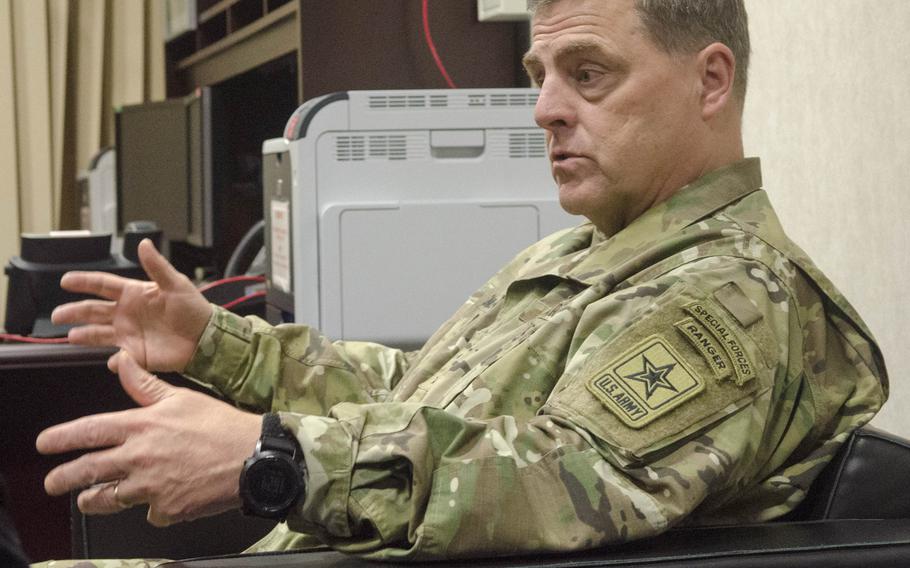
Gen. Mark Milley, chief of staff of the Army, speaks to reporters at U.S. Army Europe headquarters in Wiesbaden, Germany, Tuesday, Oct. 27, 2015. Milley signaled that an era of steadily drawing down in Europe should be halted. (Dan Stoutamire/Stars and Stripes)
WIESBADEN, Germany — The U.S. Army is reviewing its force structure in Europe, measuring everything from crisis-response capabilities to its mix of armor and infantrymen, as the service adapts to counter a revanchist Russia, the Army chief of staff said.
Gen. Mark Milley, who was at U.S. Army Europe headquarters in Wiesbaden this week to confer with more than 30 European army generals, signaled that an era of steadily drawing down in Europe should be halted.
“We don’t need Cold War-levels of forward-deployed forces or anything like that,” Milley said in an interview on Tuesday. “But at the same time, you want to make sure you have sufficient capabilities to deter further aggression by Russia.”
The Army review has no set deadline for completion, but recommendations will eventually be submitted to the Pentagon and subject to approval by the White House.
Since Russia’s intervention in Ukraine last year, the U.S. military has worked to transform its presence in Europe — moving more ships, aircraft and troops into the region — even as it faces budget constraints.
In the case of the Army, more than two decades of drawing down has left the service with only about 28,000 soldiers, a sharp decline from Cold War numbers that neared 300,000. That has forced USAREUR to come up with novel ways to demonstrate force, such as high-profile road marches to show the Army’s ability to move large numbers of forces around the Baltics and Poland. To bolster its presence in eastern Europe, USAREUR has relied on a steady stream of rotational forces from the States. Less than two years after all battle tanks were moved out of Europe, the Army brought back about 250 tanks and other heavy vehicles, which will eventually be positioned in NATO states along Russia’s periphery.
Milley said he expects more forward-positioning of equipment as well as a larger rotational presence.
The U.S. approach to the security situation in Europe is one of “strength and balance,” said Milley, adding the Army’s piece “leans more toward the strength part of that equation.”
The force-structure review will touch numerous other areas. These include the right blend of forces and the need for air defense assets and more logistical know-how on the Continent, such as bridging capabilities. The U.S. now relies entirely on allies to move ground troops across rivers because it lacks forward-deployed mobile bridging, a capability U.S. military officials in Europe have said they need.
“We’ll look at that and try and figure out the right balance,” Milley said.
Since last year, concern about Russian military operations has spread from eastern Europe to the Mediterranean and beyond. Moscow has been deploying more ships in the Mediterranean, and it has recently intervened forcefully in Syria, launching airstrikes since late September against Islamic State targets and opponents of the Bashar Assad regime.
During the conference of Army chiefs in Wiesbaden, Moscow’s deployment of military forces in recent years was the focus of much of the talk, said Milley, who after a final round of discussions on Wednesday departed for Ukraine to meet with U.S. soldiers training alongside Ukrainian forces.
Milley, who took over as the Army’s new chief in August, has called Russia the U.S.’s top military threat.
Russia’s interventions in Ukraine and Syria reflect the sweeping reforms its military has undergone since a brief war with Georgia in 2008. While the U.S. and its European allies enjoy a decided military advantage over Moscow in the number of ground forces and naval and air-combat capabilities, Moscow has the upper hand in geography, experts say: In the short-term, it could quickly overwhelm NATO allies in the Baltics, which have very limited defenses and are isolated from NATO’s major powers, where the bulk of the alliance’s military power is based.
“A major military escalation on the European continent is not imminent, but it cannot be ruled out,” the European Council on Foreign Relations said in an October report, which concluded that Europe and the U.S. have underestimated Russia’s military reforms. “Russia is clearly preparing itself for offensive operations.”
Milley, who previously commanded U.S. Army Forces Command before assuming the Army’s top post, said it was hard to know Moscow’s next move, but its improved capabilities and recent history of intervention in Ukraine raise questions.
“It is an indicator of potential future behavior that unless stopped and curbed could lead to bad things,” Milley said. “I don’t know what Russia is going to do in the future, no one does. But I do know what they have done since 2008, and I do know their capabilities. And that is cause for concern.”
However, Moscow shouldn’t underestimate the capabilities of the 28-nation NATO alliance and its collective advantage in firepower, Milley said.
“Russia doesn’t have 28 allies,” he said. “That should cause some pause if I was sitting over in Moscow.”